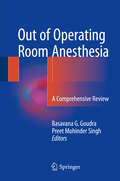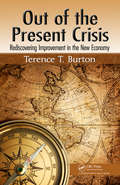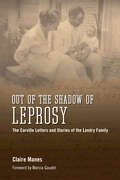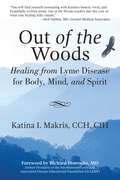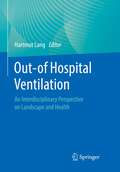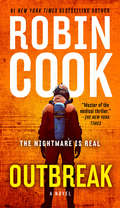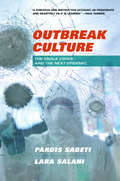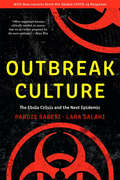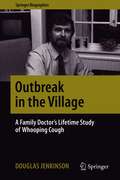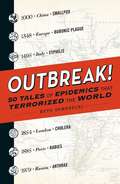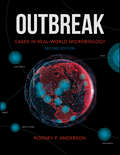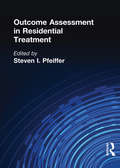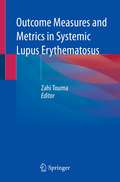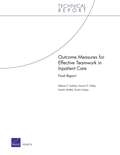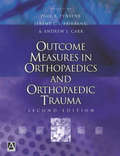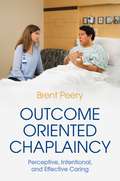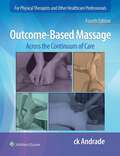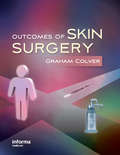- Table View
- List View
Out of Operating Room Anesthesia: A Comprehensive Review
by Basavana G. Goudra Preet Mohinder SinghThis book covers all aspects of out of operating room anesthesia and deep sedation practice. The practical aspects of anesthesia are emphasized, with particular stress on management of un-anticipated adverse events. A concise, yet comprehensive description of relevant basic sciences is also included. Although the contributors are predominantly North American, essential elements of out of OR practice in countries other than the USA are incorporated.Situations like those that contributed to the death of Joan Rivers are addressed with particular emphasis on their recognition, prevention and management. The importance of safety as the key element in providing anesthesia in remote or unfamiliar areas is highlighted and discussed. A lack of accurate documentation is a major drawback in out of OR anesthesia practice and the reader is drawn to the importance of documentation, both from a practical and medico legal standpoint. A separate chapter deals with research and future directions in out of OR anesthesia. Out of Operating Room Anesthesia: A Comprehensive Review, is primarily aimed at all anesthesia providers: anesthesiologists, nurse anesthetists and residents. Specific chapters such as dental anesthesia, anesthesia for ER procedures and sedation for cosmetic procedures will be useful as a reference guide to physicians exposed to brief training in anesthesia during their non-anesthesia residency program.
Out of Sight, Not Out of Mind: Personal and Professional Perspectives on Age-Related Macular Degeneration
by Lindy BergmanOut of Sight, Not Out of Mind presents a personal account of living successfully with age-related macular degeneration (AMD), combined with powerful new information on effective service delivery. Ninety-three-year old Lindy Bergman illustrates the ways in which life with low vision can be lived with independence, dignity, and personal satisfaction. Also included are highly informative chapters, written by the world-renowned experts from The Chicago Lighthouse for People Who are Blind or Visually Impaired, encompassing the latest information about the causes and treatment of AMD; a concise, informative overviews of the effects of aging on vision, the emotional and psychological components of vision loss and the integration of the individual's psychological recovery into low vision service delivery; and a cutting-edge model of rehabilitation that meets the challenges of service provision today. Foreword by Jonathan Safran Foer, award-winning author of Everything Is Illuminated and Extremely Loud and Incredibly Close.
Out of the Gray, into the Light: A Mother Stands Up for Her Daughter and Herself in a Fight for Survival—A Memoir of Advocacy and Hope
by Amy PostAmy Post&’s Out of the Gray, into the Light is a gut-wrenching story of parental helplessness following their daugther&’s diagnosis of malignant liver cancer, and it shares the raw, unfiltered emotions of a family suddenly sucked into a healthcare system that often leaves weakened patients to stand silent and alone, in desperate need of an advocate.&“Now I know what it is to advocate for someone, to put everything I have into something outside of myself.&” —Amy Post &“Your daughter has malignant liver cancer.&” For Amy Post and her family, the doctor&’s words shook their world and changed the trajectory of their lives forever. When Amy received a call from her children&’s school telling her that her daughter wasn&’t playing but was instead sitting down on the playground, her mind went into high alert. For months, she&’d had a nagging suspicion that something wasn&’t right with her three-year-old. Exhaustion, random fevers, and now this. Amy and her husband were not prepared, though, for the devastating diagnosis. Nor were they ready for the unveiling of a rare gene that promised not one, but three devastating forms of cancer throughout their child&’s life—if she survived this one. In her book, Amy Post shares the raw, unfiltered emotions of a family suddenly sucked into a healthcare system that runs as a machine but often leaves weakened patients to stand silent and alone and in desperate need of an advocate. It&’s a gut-wrenching story of parental helplessness that grows into a mother&’s determination and fierce fight for survival for her daughter—and then for herself.
Out of the Present Crisis: Rediscovering Improvement in the New Economy
by Terence T. BurtonToday, organizations have achieved an overall failure rate above 80 percent with Lean, Six Sigma, Lean Six Sigma, and continuous improvement in general. This is certainly not due to a shortage of books, consultants, and other online resources about the methodologies and tools, or the success stories of Toyota and others. However, it is due to a shortage of knowledge and practice about the most critical success factors of improvement: leadership, sustaining infrastructure, behavioral and cultural transformation, and now emerging technology. These factors produce 90 percent of the success with continuous and sustainable improvement; the methodologies and tools represent an irrelevant 10 percent. For decades, most organizations have focused on this quick and easy, irrelevant 10 percent through an endless series of fad, in-vogue improvement programs as they attempt to mimic the best-in-class practices of the most successful organizations.Out of the Present Crisis: Rediscovering Improvement in the New Economy is the contemporary version of Deming’s famous 1982 book, "Out of the Crisis." The author builds a solid case for organizations to aggressively pursue the next generation of systematic and sustainable improvement through a combined strategy of Deming’s back-to-basics, innovation and breakthrough thinking, integration of emerging and enabling technology, and adaptive improvement across diverse environments and industries. The book’s practical, pragmatic style is backed up by many real world examples and personal experiences.If you're looking for another book about Lean or Six Sigma "tools" this is not it. But it is a book about how to achieve lasting success by making improvement the cultural standard of excellence and living code of conduct in organizations. This popular book provides executives with an up-to-date and proven reference guide for rediscovering successful systematic and sustainable improvement in today’s economy. The author demonstrates the importance of viewing improvement as a continuous manageable "process" and covers the most critical success factors of leadership, sustaining infrastructure, behavioral and cultural transformation, and emerging technology in a practical, no-nonsense, "how-to-do" style. The book provides specific guidance for all industries including public and private corporations, hospitals, financial services, airlines, municipalities, and federal, state, and local governments.
Out of the Shadow of Leprosy: The Carville Letters and Stories of the Landry Family
by Claire ManesIn 1924 when thirty-two-year-old Edmond Landry kissed his family goodbye and left for the leprosarium in Carville, Louisiana, leprosy, now referred to as Hansen's disease, stigmatized and disfigured but did not kill. Those with leprosy were incarcerated in the federal hospital and isolated from family and community. Phones were unavailable, transportation was precarious, and fear was rampant. Edmond entered the hospital (as did his four other siblings), but he did not surrender to his fate. He fought with his pen and his limited energy to stay connected to his family and to improve living conditions for himself and other patients Claire Manes, Edmond's granddaughter, lived much of her life gripped by the silence surrounding her grandfather. When his letters were discovered, she became inspired to tell his story through her scholarship and his writing. Out of the Shadow of Leprosy: The Carville Letters and Stories of the Landry Family presents her grandfather's letters and her own studies of narrative and Carville during much of the twentieth century. The book becomes a testament to Edmond's determination to maintain autonomy and dignity in the land of the living dead. Letters and stories of the other four siblings further enhance the picture of life in Carville from 1919 to 1977.
Out of the Woods: Healing from Lyme Disease for Body, Mind, and Spirit
by Richard Horowitz Katina I. MakrisHope and practical help for Lyme disease sufferers everywhere.More than 300,000 people in the United States are diagnosed with Lyme disease every year, and many, many more are suffering from Lyme without knowing it. Katina Makris was one of those undiagnosed individuals who nearly died from the disease. At the peak of her career, classical homeopath and health-care columnist Katina Makris was stricken with a mysterious "flu.” Only after five years of torment-two completely bedridden-and devastating blows to her professional and family life was Katina’s illness finally diagnosed as Lyme disease. Out of the Woods not only shares the brutality of Lyme disease through the telling of Katina’s story, but it also describes her incredible journey back to full recovery, giving thousands of Lyme sufferers hope for their uncertain and frightening futures.Katina’s memoir is a gripping and inspiring story of healing through faith and perseverance, but Out of the Woods extends beyond Katina’s personal story. Putting her homeopathic training to work, Part Two of the book details the nuts and bolts of Lyme disease, offering readers up-to-date information on Eastern and Western treatments. Readers will learn about the importance of antibiotics as well as acupuncture, homeopathic remedies, energy restoration, and a path to emotional healing, affirming that complete healing from any disease encompasses body, mind, and spirit.
Out-of Hospital Ventilation: An Interdisciplinary Perspective on Landscape and Health
by Hartmut LangSafe handling of patient and device in home ventilation!This book offers all relevant contents of the further training "Basic qualification extra-clinical artificial respiration" and addresses itself to maintaining and responsible persons, who supply ventilated humans at home or in the nursing home. Learn comprehensive basics about anatomy, pathology and the different ventilation modes and benefit from the authors' wealth of experience. Here you can read in an easily understandable and concise manner how to provide your patients or residents with all-round competent care and how to handle the ventilation situation with confidence.Ideal for all employees and nursing services to train and qualify for the challenging care of ventilated patients!
Outback Encounter
by Meredith WebberTwo doctors — small town — big secret! Dr. Caitlin O'Shea's biggest problem is usually getting taken seriously as a research scientist — her stunning blond looks get in the way! So she's not expecting her work in tiny Outback town Turalla to have as many challenges as it does. Challenges such as remembering her clinical skills to help the town's overworked doctor. Discovering why that doctor, Connor Clarke, is so opposed to her research. And coping with what his irresistible smile does to her mind, body and heart!
Outback Engagement
by Meredith WebberFake engagement…real passion! Outback vet Tom Fleming has a problem with women — they want to marry him! After being featured in a magazine, the so-called "Lonely Country Bachelor" is surrounded by would-be wives, his ex and a hotshot reporter! Merriwee's new doctor, Anna Talbot, is beautiful, blond and engaged. So when Tom claims he gave her the ring, the fake fiancee ends all his woman troubles…except one. Because, as Tom and Anna face medical — and animal — emergencies together,Tom realizes that the woman he can't have is the only one he wants.
Outback Marriage
by Meredith WebberIt was bad enough that Blythe Jones had to sit next to — and dance with! — rude, challenging, dangerously attractive Cal Whitworth at the wedding. It was definitely too much when his plane crashed on the way back and the two doctors had to spend the night in the wild. And as for his plea that Blythe should work in his Outback practice while his broken arm healed...well! But for some reason Blythe agreed. And the more she saw Cal — his dedication, his caring, his unnervingly sexy smile — the harder it was to remember why she was off men....
Outbreak
by Robin CookMurder and intrigue reach epidemic proportions when a devastating plague sweeps the country. Dr. Marissa Blumenthal of the Atlanta Centers for Disease Control investigates--and soon uncovers the medical world's deadliest secret...
Outbreak Culture: The Ebola Crisis and the Next Epidemic
by Pardis SabetiAn award-winning genetic researcher and a tenacious journalist examine each phase of the Ebola epidemic in West Africa, the largest and deadliest of its kind. Their postmortem identifies factors that kept key information from reaching doctors, complicated the government’s response to the crisis, and left responders unprepared for the next outbreak.
Outbreak Culture: The Ebola Crisis and the Next Epidemic, With a New Preface and Epilogue
by Pardis Sabeti Lara SalahiA Choice Outstanding Academic Title of the Year “A critical, poignant postmortem of the epidemic.” —Washington Post “Forceful and instructive…Sabeti and Salahi uncover competition, sabotage, fear, blame, and disorganization bordering on chaos, features that are seen in just about any lethal epidemic.” —Paul Farmer, cofounder of Partners in Health “The central theme of the book…is that common threads of dysfunction run through responses to epidemics…The power of Outbreak Culture is its universality.” —Nature “Sabeti and Salahi present a wealth of evidence supporting the imperative that outbreak response must operate in a coordinated, real-time manner.” —Science As we saw with the Ebola outbreak—and the disastrous early handling of the COVID-19 coronavirus pandemic—a lack of preparedness, delays, and system-wide problems with the distribution of critical medical supplies can have deadly consequences. Yet after every outbreak, the systems put in place to coordinate emergency responses are generally dismantled. One of America’s top biomedical researchers, Dr. Pardis Sabeti, and her Pulitzer Prize–winning collaborator, Lara Salahi, argue that these problems are built into the ecosystem of our emergency responses. With an understanding of the path of disease and insight into political psychology, they show how secrecy, competition, and poor coordination plague nearly every major public health crisis and reveal how much more could be done to safeguard the well-being of caregivers, patients, and vulnerable communities. A work of fearless integrity and unassailable authority, Outbreak Culture seeks to ensure that we make some urgently needed changes before the next pandemic.
Outbreak in Washington, D. C.: the 1857 Mystery of the National Hotel Disease (Disaster Ser.)
by Kerry WaltersAn account of the mysterious epidemic among nineteenth-century hotel guests that &“enthralled the country and nearly took the life of the-President-elect&”(The Washington Post). The National was once the grandest hotel in the capital. In 1857, it twice hosted President-elect James Buchanan and his advisors, and on both occasions, most of the party was quickly stricken by an acute illness. Over the course of several months, hundreds fell ill, and over thirty died from what became known as the National Hotel disease. Buchanan barely recovered enough to give his inauguration speech. Rumors ran rampant across the city and the nation. Some claimed that the illness was born of a sewage &“effluvia,&” while others darkly speculated about an assassination attempt by either abolitionists or southern slaveowners intent on war. In this concise and captivating account of the events—as well as the panic and rumors surrounding them—Kerry Walters investigates the mysteries of the National Hotel disease.
Outbreak in the Village: A Family Doctor's Lifetime Study of Whooping Cough (Springer Biographies)
by Douglas JenkinsonOutbreak in the Village is a fascinating account of the personal and professional journey of Dr. Doug Jenkinson, physician and researcher. Over the course of four decades in practice, Jenkinson traces the reemergence of whooping cough in the developed world, using his practice in the idyllic English countryside as a clinical control group. Keeping meticulous notes and indulging an itch to investigate, he explores one of history's most enigmatic and pervasive diseases. Jenkinson relates the tale of his life's work amid winsome anecdotes, relevant history, and practical advice. Told in an amiable, engaging voice with an expert balance of levity and earnestness, this story will charm casual readers interested in medical history and memoir, as well as doctors and researchers who identify with the experiences and may benefit from the research and techniques employed. Readers will find themselves in the examination room beside Jenkinson as the investigation unfolds, learning about the nature of the illness and the sweeping detrimental effects of an anti-vaccination campaign. An intriguing memoir about a mysterious illness, a public health failure, and one doctor's quest for clarity, Outbreak in the Village is a tale of perseverance and objectivity sure to delight and inform.
Outbreak!: 50 Tales of Epidemics That Terrorized the World
by Beth SkwareckiFrom ancient scourges to modern-day pandemics! Throughout history--even recent history--highly contagious, deadly, and truly horrible epidemics have swept through cities, countrysides, and even entire countries. Outbreak! catalogs fifty of those incidents in gruesome detail, including:The Sweating Sickness that killed 15,000, including Henry VIII's older brotherSyphilis, the "French Disease," which spread throughout Europe in the late fifteenth centuryThe romantic disease: tuberculosis, featured in La Boheme, La Traviata, and Les MiserablesThe worldwide outbreak of influenza in 1918, which killed 3 percent of the populationThe mysterious appearance of HIV in the 1980sThe devastating spread of Ebola in West Africa in 2014From ancient outbreaks of smallpox and plague to modern epidemics such as SARS and Ebola, the stories capture the mystery and devastation brought on by these diseases. It's a sickeningly fun read that confirms the true definition of going viral.
Outbreak: Cases in Real-World Microbiology (ASM Books)
by Rodney P. AndersonOutbreak: Cases in Real-World Microbiology, 2nd Edition, is the newest edition of this fascinating textbook designed for introductory microbiology students and instructors. Thoroughly revised, this collection of case studies of real-world disease outbreaks, generously illustrated in full color, offers material that directly impacts college-level students, while the book's unique presentation offers instructors the flexibility to use it effectively in a number of ways. More than 90 outbreak case studies, organized into six sections according to the human body system affected, illustrate the wide range of diseases caused by microbial pathogens. The studies are presented at differing levels of difficulty and can be taught at all undergraduate levels. Each case study includes questions for students to think about, discuss, and answer, and the book includes an appendix that directs students to the specific reference material on which each case was based, providing the opportunity to investigate further and to apply the reference content to the case being studied. Each of the six sections of the book concludes with a College Perspective and a Global Perspective case study. The College Perspective provides a direct and practical link between the microbiology course and the daily lives of students. The Global Perspective connects students with outbreaks that have occurred in countries around the world to facilitate understanding of the social, religious, economic, and political values at play in the treatment and prevention of infectious disease. At the end of every section, detailed descriptions offer concise yet complete information on each disease involved in that section.
Outcome Assessment in Residential Treatment
by Steven I PfeifferAs residential treatment centers and psychiatric hospitals are increasingly asked to document their effectiveness, it is essential for mental health care providers to demonstrate the efficacy and cost-effectiveness of the services they provide. Outcome Assessment in Residential Treatment helps health care providers demonstrate that their planned treatment is necessary and active rather than simply custodial. A practitioner’s guide to conducting treatment outcome assessment projects, this innovative book presents readers with historical perspectives, current issues, and practical suggestions for implementing an outcome assessment project.Outcome Assessment in Residential Treatment guides psychiatrists, psychologists, mental health practitioners, and social program administrators in addressing which therapeutic components contribute to the goals and objectives of their programs and which may require modification, radical revision, or even elimination. It helps residential treatment centers and psychiatric treatment facilities document treatment successes and better understand which factors (within the client, family, environment, treatment setting, or combinations therein) predict successful outcome. This objective data empowers readers to influence government and industry, enhance public awareness of the needs of severely disturbed children and youth, and validate the usefulness of intensive psychiatric treatment.Unlike other books on treatment outcome, Outcome Assessment in Residential Treatment tells readers how to determine clinically significant improvement and not simply statistically significant change. It gives practical, detailed, proven advice on how to carry out studies that will benefit residential treatment centers and the psychiatric and mental health fields. Contributors provide tools to validate/demonstrate that psychiatric and mental health treatments are effective. They offer insight into: planning a treatment outcome project recognizing ethical, practical, methodological, logistical, and clinical considerations in implementing a treatment outcome project selecting instruments to assess treatment outcome and measuring success comparing different outcome measuresHealth care providers must have accurate information about treatment outcomes to demonstrate that specific services are beneficial, cost-effective, and well-received by the client. Outcome Assessment in Residential Treatment helps readers evaluate the impact a treatment program has on a client’s clinical status and psychosocial and educational functioning, making it possible to provide an objective yardstick for the payer’s evaluation of the quality of care provided.Psychiatrists, psychologists, mental health practitioners, and social program administrators will find Outcome Assessment in Residential Treatment an essential guide to evaluating and understanding the relative effects of specific interventions or procedures on the quality and effectiveness of their services. They will use this information to make appropriate changes which guarantee that they best meet their clients’mental health care needs.
Outcome Measures and Metrics in Systemic Lupus Erythematosus
by Zahi ToumaSystemic Lupus Erythematosus (SLE) is a chronic autoimmune disease that manifests with a myriad of clinical and laboratory features. The assessment of SLE is comprehensive and includes different core set domains; disease activity, damage, health-related quality of life, adverse events and economic impact. This comprehensive book is focused on the instruments and outcome measures utilized in the assessment of SLE. It targets different audiences including physicians, scientists/researchers and different health professionals interested in learning about the art of measurement in SLE. The book highlights the importance of measurement in the assessment of SLE in a clinical settings, research and clinical trials. Each of the chapters provide a systematic approach to the instruments utilized in the assessment of a specific construct in SLE (e.g., disease activity, fatigue, etc.) and incorporate a comprehensive coverage of disease specific and disease generic measures. It also discusses different patient-reported outcomes that are crucial to reflect patient perceptions of their health condition and cover constructs such as fatigue, pain, anxiety and depression, cognition, frailty, and many others.
Outcome Measures for Effective Teamwork in Inpatient Care
by Donna O. Farley Susan L. Lovejoy Melony E. Sorbero Soeren MattkeAddresses one step in the process of moving from teamwork training to teamwork practices that improve outcomes of care: identifying outcomes that are most likely to be affected as teamwork practices improve in an implementing organization. Discusses a literature search, methods for selecting and testing candidate measures, measures highly rated by clinical experts, and results of measure testing on administrative data of the DoD health system.
Outcome Measures in Orthopaedics and Orthopaedic Trauma, 2Ed
by Jeremy Fairbank Paul Pynsent Andrew CarrOrthopaedics and orthopaedic trauma are highly complex subjects that can prove difficult to quantify, but accurate measurement is required for setting standards of care and for assessing the severity of an injury. This book will help the reader assess outcome instruments, and provides many references to sources of instruments and techniques to use.
Outcome Oriented Chaplaincy: Perceptive, Intentional, and Effective Caring
by Brent PeeryOutcome Oriented Chaplaincy (OOC) is a method of chaplaincy care that emphasizes achieving, describing, measuring, and improving the outcomes that result from a chaplain's work, alongside the parallel framework of evidence-based healthcare. This book examines the underlying principles of OOC and incorporates first-hand accounts of chaplains who have made a measured difference to patients and their families. Brent Peery draws on more than fifteen years of experience within the field of Outcome Oriented Chaplaincy, exploring its evolution and history within the complex culture of healthcare, and how its underlying principles of assessments, interventions, outcomes and documentation are most effectively put into practice. This practical guide will benefit chaplains interested in the approach of OOC, and identify a framework for providing the best spiritual care for those facing life's most difficult moments.
Outcome-Based Massage: Across the Continuum of Care
by Carla-Krystin AndradePraised for its engaging approach and contemporary coverage, Outcome-Based Massage: Across the Continuum of Care, 4th Edition, continues a tradition of excellence in equipping students for success on board reviews and transitioning theory into clinical practice. Reflecting the fields of massage therapy, physical therapy, athletic training, education, psychology, medicine, and physiology, author ck Andrade and a team of experts deliver a comprehensive understanding of Outcome-Based Massage™ and its clinical applications at an accessible breadth and depth. This extensively updated edition integrates principles and techniques across the continuum of care and aligns content with the latest evidence, clinical practice guidelines, and healthcare regulations to help users confidently meet clients’ unique needs and achieve superior treatment outcomes.
Outcomes Measurement in the Human Service: Cross-Cutting Issues and Methods (2nd Edition)
by Jennifer L. Magnabosco Ronald W. Manderscheidhe book provides readers with both macro- and micro-perspectives on the topics of outcomes measurement; incorporates practice, policy, and research perspectives; and examines current and long-standing issues within the human services field with regard to outcomes and performance measurement. With numerous authors from the field of social work, this new edition of Outcomes Measurement in the Human Services also boasts contributions from professionals in the fields of psychology, psychiatry, policy research, administration, and numerous other social sciences. With its thorough, authoritative coverage of the issues of outcomes measurement and accountability, this book is appropriate for and directly relevant to courses in evaluation research, clinical practice, social policy, and administration.
Outcomes of Skin Surgery: A Concise Visual Aid
by Graham ColverThere is a great need for a visual resource to document, with clarity, the possible outcomes of surgery, including side effects and complications, and how these outcomes vary from individual to individual. Using a straightforward approach, Outcomes of Skin Surgery: A Concise Visual Aid is an easy-to-consult and highly illustrated reference for surg
